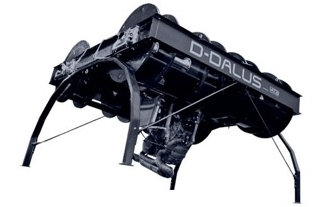IAT21, an Austria-based company, has drafted a group of Cranfield University engineers to develop its prototype vehicle. The D-Dalus vehicle was recently introduced by the company at the Royal Aeronautical Society. The vehicle utilizes four rotor assemblies to fly at a maximum speed of 400kph.
 D-Dalus is designed to fly in any direction at up to 400kph
D-Dalus is designed to fly in any direction at up to 400kph
The company aspires to develop an autonomous vehicle, which can fly through radiation and smoke and in any weather conditions. The vehicle will also hover near buildings and enter them to deliver or collect materials or recover casualties. The company mentions that the D-Dalus vehicle can hover above the ground at a distance of 3m.
Each rotor assembly has a set of disks linked by numerous blades with adaptable angles. The assemblies can be adjusted by a computer solution and can rotate at a speed of 2,200 rpm. The company is utilizing its existing engine technology to decrease maintenance requirements. The engineers from Cranfield are helping the company with wind-tunnel testing and engine selection.
IAT21’s Leader of the D-Dalus Project, David Wills stated that the aircraft project would take a minimum of five years to grow into a mature technology. The company has submitted proposals to the US, French, and British ministries of defense for the aircraft. It also has spoken to numerous companies such as AgustaWestland and EADS.